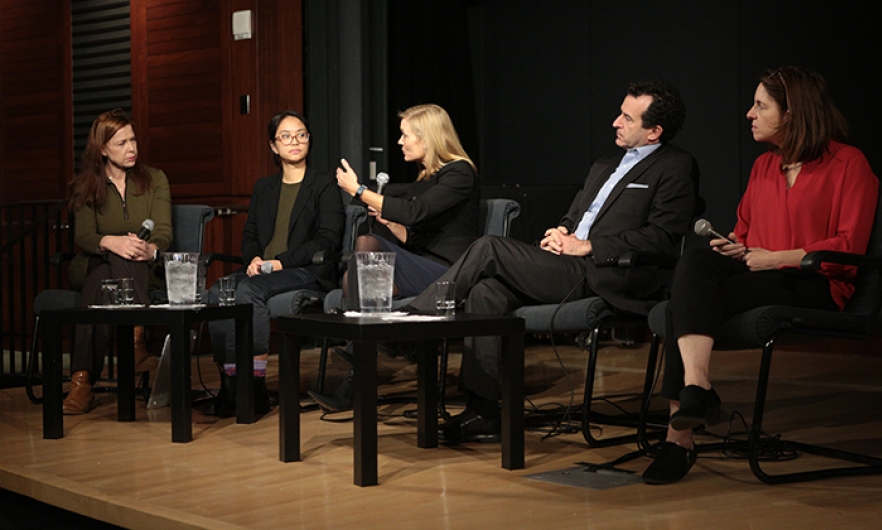Surviving Trauma: Johns Hopkins-Pulitzer Center Symposium

A conversation about journalism and public health (left to right): Kim Dozier, Pat Nabong, Laura Murray, Paul Spiegel, Judy Bass. Watch the full conversation here.
Surviving Trauma: Stories of Pain and Possibility
By Isabella Gomes
As various crises grab footholds in countries around the world, survivors of conflict, violence, and displacement are left to grapple with the resulting trauma and pain.
Given the persistence of the mental health epidemic, journalists reporting on war zones, refugee emergencies, child separation, and gender-based violence must also cover the psychological effects of these tragedies. One of their greatest resources in providing responsible, sensitive reportage—besides their subjects in the field—are public health experts who have spent their lives researching the experiences of trauma and resilience.
At the seventh annual Johns Hopkins-Pulitzer Symposium in December, Bloomberg School faculty and award-winning journalists from the Pulitzer Center on Crisis Reporting came together to discuss the effects of trauma and the paths toward healing.
“The relationship between researchers and journalists in this domain of public health is critical,” says Judy Bass, PhD ’04, MPH.
As moderator of the panel discussion, Bass, an associate professor of Mental Health, highlighted the need for collaboration between journalists and public health practitioners. This teamwork ensures that journalists understand the current science, psychology, and risk factors of trauma, and also that public health researchers effectively communicate their findings, particularly to the people most in need of services.
“Trauma affects people, families, and communities differently,” Bass adds. “These differences provide opportunities to tell stories in new ways [and] to keep the readers and viewers engaged, so that they don’t become immune to the stories and traumas going on around us.”
TRAUMA & COMPOUNDING HEALTH ISSUES
An exacerbator to the wide range of mental health experiences is the ubiquity of comorbidities, says panelist Laura Murray, PhD, MA. Currently, Murray, a senior scientist in the Bloomberg School’s Department of Mental Health, works on the development and implementation of effective and scalable treatments for a range of mental health issues in multiple low and middle income countries.
In Murray’s experience as a clinician, “no one comes in with just depression,” she says. “Yet, despite us knowing that comorbidities are the norm, our [patient care] approach is siloed.” Programs that focus on one disorder rarely succeed in improving overall patient health, and are often resource-intensive, inefficient, and unsustainable.
In addition to challenges on the clinical side, says Pat Nabong, are the barriers that patients themselves experience in accessing mental health services. Nabong, a freelance visual journalist based in Chicago, received funding from the Pulitzer Center to explore the psychological toll of President Rodrigo Duterte’s extrajudicial drug war in the Philippines. The war has killed more than 7,000 people—largely drug dealers and users from low-income communities.
The barriers to mental health resources in the Philippines, says Nabong, include a lack of awareness about mental health, the inaccessibility of healthcare services, the stigma associated with seeking care and, most importantly, economic limitations.
“People affected by the drug war come from low-income communities,” says Nabong. “These people are in survival mode, meaning they’re already struggling to put food on the table [so] it can be difficult for them to prioritize their mental health needs.”
Sadly, such national policies that infringe on basic human rights often give rise to long-term mental health problems in vulnerable communities, particularly among children.
A clear example, says Paul Spiegel, MD, MPH ’96, can be seen at the southern United States border where children are being separated from families seeking asylum. “Trauma early in the life contributes to a broad range of serious health outcomes, including social impairment, disease and disability, and early death,” he says
Spiegel, director of the Center for Humanitarian Health, is recognized internationally for his research on preventing and responding to complex humanitarian emergencies. He adds: “Prolonged trauma in children can affect the architecture of their brains because they’re not yet fully formed. The toxic stress puts the brain into a continuous fight or flight mode.”
ETHICAL REPORTING
Kimberly Dozier, a CNN Global Affairs Analyst who writes for TIME and The Daily Beast, says she’s personally wrestled with the challenges of reporting on trauma and violence among child victims. “There is no way to interview children without causing them trauma, but [there is] the greater good of telling people about this forgotten story; [otherwise] no one is going to help these kids,” says Dozier, who recently covered a TIME profile on Yazidi boys who had been forced to be child soldiers for ISIS.
In her reporting, Dozier says she took precautions to protect their identities, exclusively interviewed children accompanied by guardians or caregivers, and sought guidance from mental health experts on how to best approach questions that were potentially triggering.
To this end, public health and mental health researchers can be a tremendous resource to journalists, says Dozier, particularly if they are responsive and open-minded. This collaborative relationship between journalists and public health practitioners also helps give researchers another mechanism through which to advocate evidence-backed solutions.
“Research and reporting are both critical to communicating what’s in the world around us and how we can make an impact to reduce suffering, even if we cannot eliminate the traumas themselves,” says Bass.
Related Content
From Science to Story: Science Journalism in the Age of Fake News—2018 Johns Hopkins-Pulitzer Symposium
